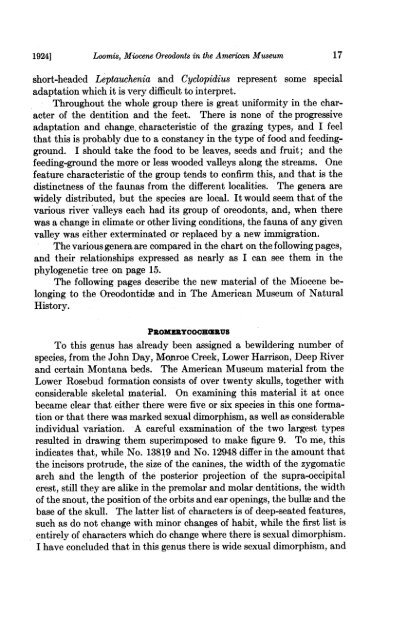View/Open - American Museum of Natural History
View/Open - American Museum of Natural History
View/Open - American Museum of Natural History
Create successful ePaper yourself
Turn your PDF publications into a flip-book with our unique Google optimized e-Paper software.
1924] Loomis, Miocene Oreodonts in the <strong>American</strong> <strong>Museum</strong><br />
17<br />
short-headed Leptauchenia and Cyclopidius represent some special<br />
adaptation which it is very difficult to interpret.<br />
Throughout the whole group there is great uniformity in the character<br />
<strong>of</strong> the dentition and the feet. There is none <strong>of</strong> the progressive<br />
adaptation and change, characteristic <strong>of</strong> the grazing types, and I feel<br />
that this is probably due to a constancy in the type <strong>of</strong> food and feedingground.<br />
I should take the food to be leaves, seeds and fruit; and the<br />
feeding-ground the more or less wooded valleys along the streams. One<br />
feature characteristic <strong>of</strong> the group tends to confirm this, and that is the<br />
distinctness <strong>of</strong> the faunas from the different localities. The genera are<br />
widely distributed, but the species are local. It would seem that <strong>of</strong> the<br />
various river valleys each had its group <strong>of</strong> oreodonts, and, when there<br />
was a change in climate or other living conditions, the fauna <strong>of</strong> any given<br />
valley was either exterminated or replaced by a new immigration.<br />
The various genera are compared in the chart on the following pages,<br />
and their relationships expressed as nearly as I can see them in the<br />
phylogenetic tree on page 15.<br />
The following pages describe the new material <strong>of</strong> the Miocene belonging<br />
to the Oreodontidae and in The <strong>American</strong> <strong>Museum</strong> <strong>of</strong> <strong>Natural</strong><br />
<strong>History</strong>.'<br />
PROMMYCOCHMRUS<br />
To this genus has already been assigned a bewildering number <strong>of</strong><br />
species, from the John Day, Monroe Creek, Lower Harrison, Deep River<br />
and certain Montana beds. The <strong>American</strong> <strong>Museum</strong> material from the<br />
Lower Rosebud formation consists <strong>of</strong> over twenty skulls, together with<br />
considerable skeletal material. On examining this material it at once<br />
became clear that either there were five or six species in this one formation<br />
or that there was marked sexual dimorphism, as well as considerable<br />
individual variation. A careful examination <strong>of</strong> the two largest types<br />
resulted in drawing them superimposed to make figure 9. To me, this<br />
indicates that, while No. 13819 and No. 12948 differ in the amount that<br />
the incisors protrude, the size <strong>of</strong> the canines, the width <strong>of</strong> the zygomatic<br />
arch a'nd the length <strong>of</strong> the posterior projection <strong>of</strong> the supra-occipital<br />
crest, still they are alike in the premolar and molar dentitions. the width<br />
<strong>of</strong> the snout, the position <strong>of</strong> the orbits and ear openings, the bullwe and the<br />
base <strong>of</strong> the skull. The latter list <strong>of</strong> characters is <strong>of</strong> deep-seated features,<br />
such as do not change with minor changes <strong>of</strong> habit, while the first list is<br />
entirely <strong>of</strong> characters which do change where there is sexual dimorphism.<br />
I have concluded that in this genus there is wide sexual dimorphism, and

















